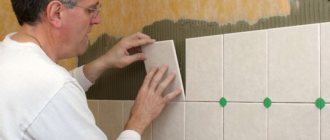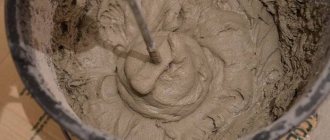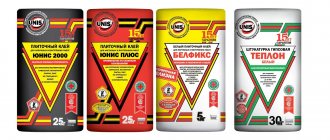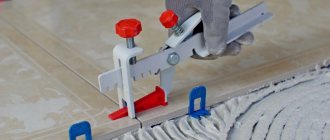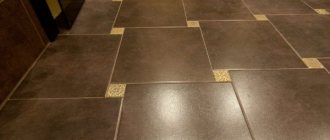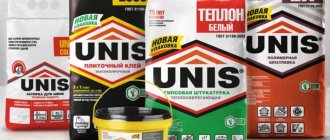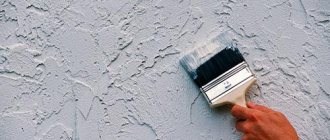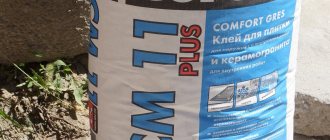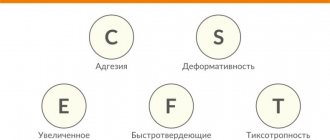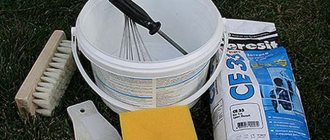The calculator contains general average data that can be used for preliminary calculations.
For large projects, it is recommended to practically test the consumption of materials on a test surface area.
Calculation data
Glue consumption, kg/m2:—
Required amount of glue, kg:—
The calculator contains general average data that can be used for preliminary calculations.
For large projects, it is recommended to practically test the consumption of materials on a test surface area.
Types of tile adhesive
There are only three types of tile adhesives on sale: dispersion, cement and epoxy.
Each of them has its own individual characteristics. Dispersive. Used for laying tiles of small thickness. Basically, it is taken by people who are far from repair work, since it is sold in a ready-to-use form.
The basis of this product is resin. The adhesive composition has such properties as plasticity, viscosity, strength. In addition, it is quite economical to use: glue consumption per 1 m² is minimal.
Glue also has a negative side: poor waterproofing qualities.
Cement. This glue is especially popular due to its ease of use, efficiency and low price. In addition, it can be used to glue tiles even in places where it looks problematic, and dismantling is very easy with minimal losses. The most common representatives of this category of glue are Unis, Ceresit, Hercules and EK.
The basis of this adhesive composition is cement. To obtain the required amount of adhesive, it is necessary to mix the cement component and water. The use of latex additives is also permitted. The consumption of this category of glue is no more than 1.9 kg per 1 m² with a layer thickness of 1 mm.
Epoxy. Preparing the composition of this glue is not easy, so it is used mainly by experienced builders. The composition of the adhesive is resin and catalyst. The liquid resin solution is mixed with a catalyst, which gives the desired effect. Well-known brands in this category include Ceresit, Litokol and Lugato.
Among the positive properties of this glue, we can note water resistance, strength, elasticity, is not afraid of temperature fluctuations, does not become cracked, adheres well to the surface and does not shrink. Among other things, the glue has an affordable price.
Frost-resistant tile adhesive for exterior use (streets)
The low water absorption of tiles and climatic conditions complicate the work of the tiler. So, if when laying ordinary tiles in a house you need to apply glue to only one base (the tile itself or the surface), then when finishing the exterior - on both.
Ceresit CM 11 Plus
The composition of Ceresit CM 11 Plus is considered classic; it is most often used for laying tiles and porcelain stoneware in exterior and interior work. The adhesive includes a number of minerals and modifying additives that provide a high degree of adhesion to various non-deformable substrates:
- concrete;
- cement coatings;
- cement-lime screeds;
- brickwork, etc.
CM 11 adhesive is suitable for gluing any type of tile, except marble, smaller than 50*50 cm on floors and walls outside, inside buildings. It can also be used for laying porcelain tiles for interior work. By adding a special elasticizer CC 83, the product can be used for the installation of waterproofing coatings, heated floors, plinths, external stairs and various deformable bases - plasterboard, chipboard. In addition, the introduction of an elasticizer helps improve the properties of the adhesive and its use for gypsum, cellular concrete, and paint coatings.
Which glue to choose?
There are three types of glue mixtures
- Cement based – cement with additives diluted with water or latex additive. The most popular and economical option. The consumption of this glue will be from 1 to 1.9 kilograms per 1 m2 when applying glue 1 mm thick.
- Dispersion type is a liquid mixture based on resin.
- The epoxy type is a mixture of liquid resin and catalyst, as a result of a chemical reaction you get an adhesive solution. It adheres well to the surface, is not subject to cracking and does not shrink.
Taking into account the dimensions of the tiles
The adhesive consumption depends on the dimensions of the tile. So, the larger the tile area, the more glue is used. For small tiles, up to 10X10 cm in size, cement adhesive when applying a thin layer of adhesive requires 2mm less. If the sides of the tile are from 20 to 30 cm, then the glue is applied with a thickness of 2-3.5 mm. If the thickness of the tile is 30×30 to 50×50, then the layer is applied approximately 3.5 to 4.5. And if the tile is large, then the layer is applied in a layer of 4 - 5 mm. The back side of the tile is also lubricated with glue.
Spatula dimensions and thickness of applied glue
The glue packaging does not indicate the thickness of the glue applied, but indicates the size of the teeth. Let's give an example: spatula 8, used for tiles 30x30 cm.
If the tile has dimensions of 50x50 cm, then use a spatula 12. After all, it is impossible to measure the thickness of the adhesive applied to the tile. Even if you apply a layer of glue evenly, it will only be visually smooth. Due to the fact that the glue is applied unevenly, the tiles may not last long.
Manufacturers advise first applying glue with the side of the spatula where there are no teeth, and then with the serrated side.
Spatulas are produced with tooth sizes of 6, 8, 12 mm. Every glue manufacturer knows its properties and the exact layer, it won’t be difficult to find out.
On the packaging of each glue, the manufacturer indicates the consumption in kilograms, this depends on the type of spatula.
Let's give an example: Ceresit CM12 glue, tiles measuring 30x30 cm, it is recommended to use a spatula with 10 mm teeth. In this case, the glue consumption is 4.2 kg per m2.
Just don’t think that if you take a spatula with 8 mm teeth, the glue layer will be 8 mm. Of course not. This is the height of the ridges of the spatula that you ran at a 90 degree angle. If you move the spatula at an angle, the initial height should be less, and when the tiles are laid, the glue will be distributed over the entire area. The adhesive layer varies from 0.3 to 0.5 the size of the spatula teeth. If you use a spatula with 8 mm teeth, the thickness of the glue will be approximately 2.4 - 4 mm.
Composition and brand of glue
The composition of the glue depends on different brands; they come with different additives. The density of the glue depends on this, that is, 25 kg bags contain different volumes of material, so the material is consumed differently. In order for the calculation of glue consumption to be accurate, you need to know the name and manufacturer.
Calculation: what needs to be taken into account
Glue is not something you should skimp on when installing. Some apply it only to the corners of the tile: the adhesion area will be insufficient and the tile is highly likely to burst from an impact or on its own, from the tension of the material.
But buying a huge supply of glue is expensive. It is better to take into account the main points and calculate everything accurately. Here's what affects glue consumption:
Glue type
- Cement is the most convenient in terms of economy - you will need 1-1.9 kg per square meter of surface.
- Dispersion mixtures do not need to be prepared; they are in working order immediately, but are suitable for tiles of small thickness.
- Epoxy-based adhesives must be mixed with a catalyst before installation, so the average adhesive consumption is difficult to calculate in advance.
Tile size
The general idea is this: the larger the tile, the more glue you need. Typically, larger tiles are heavier, so more bonding material is required to ensure a secure bond to the surface. Study the markings.
| Slab size | Adhesive layer thickness |
| up to 15 cm on the side | up to 2 mm |
| from 25×25 to 50×50cm | 4 mm |
| more than 60 cm on a side | 5-6 mm |
Tip: the shade of the glue is also important. For example, gray glue when laying glass mosaics will make the surface dull and dirty.
Type of tile and material features
More porous tiles require more adhesive. Be sure to read the information on the packaging:
- The adhesive consumption for laying porous tiles without glaze (for example, cotto tiles) is greater.
- Glazed tiles require less adhesive
- Artificial stone and porcelain tiles practically do not absorb glue.
Tip: you need more adhesive mixture if you are laying tiles with a difference in thickness, because the surface is leveled by the glue.
Laying method
The smoother the surface you get and the thinner the tile, the less glue you need. There are two installation methods.
| Laying method | How does it work | Standard consumption per square meter |
| Thin layer installation | A minimum layer is needed to adhere thin and light tiles with surface differences of no more than 3 mm. | from 1 to 5 kg |
| Thick layer installation | Needed to level a difficult surface. If you skimp on glue, bubbles may form and the tile may fall off. | Calculated individually |
Air temperature is also important: at temperatures above 25°C, the liquid in the composition evaporates faster, and more glue is needed. And in the cold, the mixture may completely lose its properties.
Advice: if the surface is complex and the tiles are heavy, apply glue not only to the surface of the wall or floor, but also to the surface of the tile itself. Glue consumption approximately doubles.
Type of styling tool
Many manufacturers indicate the amount of tile adhesive based on the tile laying tool and even the size of the trowel teeth. Here are the basic principles.
- Square-toothed spatula: the largest volume of glue,
- U-shaped tool: average consumption,
- V-shaped: minimum quantity.
The higher the teeth, the thicker the layer. For example, when using a spatula with a 4 mm comb, the Knauf Fliesen consumption will be 1.7 kg/sq.m, and when using a spatula with an 8 mm comb - 2.9 kg/sq.m. Please note that the figure implies applying glue using a spatula, which you hold perpendicularly. If the technique is different, the figure may change.
Glue calculation
As you already understand, calculating glue is not an easy task. We will try to list ways to make your task easier.
- Entrust the calculation to a specialist. If you trust the installers you have chosen, ask them to calculate the required amount of tile adhesive themselves.
- If you do the installation yourself, the algorithm is as follows:
- measure the width and length of the surface to find the area,
- look at the selected tile and decide on the installation method. If the tiles are heavy and large, the purchase volume can be safely doubled,
- Assess surface variations.
- Finally, look at the instructions and numbers on the packaging of your chosen formula.
Glue consumption per square meter - table
| Glue brand | Consumption per kg/m2 |
| Ceresit SM 11 | 4 |
| Ceresit CM 16 “Flex”, elastic | 4 |
| Bergauf Keramik Pro, reinforced | 3.6 with a layer thickness of 3 millimeters |
| Bolars Basic | 3,5 |
| Knauf Fliesen | For a spatula with a 4 mm comb: 1.7 For a spatula with a 6 mm comb: 2.2 For a spatula with an 8 mm comb: 2.9 |
| Litoplus K55 | 2.5 with a layer of 1 millimeter |
| Eunice Plus | 1,3 |
| Plitonite for porcelain tiles 60x60 cm | 1,3 |
| Perfecta Hardfix | 1,3 |
| Vetonit Stone Fix | 1.29 with a layer thickness of 1 millimeter |
| Axton | 1,25 |
| BERGAUF Mosaik | 0,84 |
A few clarifications:
- The figure indicated by the manufacturer is calculated under ideal conditions - smooth surface, careful application. Consider them, but do not consider them to be truth.
- When calculating the volume of cement adhesive, the weight of the dry mixture is taken into account, and for dispersion or epoxy adhesive, the weight of the mixture in liquid form is taken into account.
- Unless otherwise specified, consumption is calculated based on a layer thickness of 1 mm.
Calculation methods
There are many ways to calculate the required amount of glue. Let's look at each of them.
Using formulas
There is nothing difficult in this calculation: using the initial data, calculating the required amount of glue will not be difficult.
You need to know: the dimensions of your tiles and the area covered by the tiles. Now you need to divide these two quantities, that is, the coverage by the area of the tile.
Let's consider the calculation using the example of 10x10 porcelain stoneware. Its area is 100 cm². Then for 1 m² you will need 100 pieces of this tile (10000:100). 2 mm is the thickness of the layer, and the entire package of glue is 1.3 kg. Then we multiply these two values and get the final result: 2.6 kg per 1 m2 of surface. If the cladding of a room is 20 m², then you will need 52 kg of glue for the entire room.
Subtleties of application
When working, there are subtleties that should be taken into account:
- The adhesive is spread on the tiles using a notched trowel.
- You should not apply the adhesive mixture directly to a large surface area, as the formation of a dry film will reduce the quality of adhesion.
- The same distance must be maintained between the tiles (crosses must be placed); adjustments to the location are carried out within 20 minutes.
- Excess should be removed immediately after adjustment to avoid later scraping from the face of the tile.
- When laying large tiles or on a “warm floor” system, the application is combined, the solution is applied to the tile and the main surface.
- Use is prohibited within 24 hours after installation.
- The work is carried out subject to the availability of IZ funds.
- If the solution gets on exposed skin or mucous membranes, rinse with running water.
Interesting video on the topic:
Ready calculations
For the most common types of glue, there are ready-made calculations of consumption per 1 square meter. For consumer convenience, manufacturers often post this information in the instructions for the adhesive composition or on their websites:
- Ceresit glue has a consumption of 1.4 to 1.65 kg per layer of adhesive composition 1 mm thick.
- Russian-made Hercules glue has a consumption of 1.5 kg per 1 millimeter of layer.
- Litokol adhesive composition per 1 mm layer has a consumption of 1.3 to one and a half kilograms per 1 square meter.
- Tile adhesive "Unis Plus" has one of the most economical consumption rates. From 1 kg to 1.2 kg for a layer of 1 mm.
Specifications
Plitonit tile adhesive is used for laying ceramic, porcelain stoneware, clinker slabs on horizontal and vertical planes with any base.
Technical characteristics of Plitonit:
- Plitonite is produced in three series: a, b, c. Packaging is carried out in bags of 5 and 25 kg.
- The contents of the bags are a dry, gray powdery mixture. To prepare the solution, you need to dilute the powder with water according to the instructions.
- The mixture contains cement, binders, adhesive components, modifiers, and fillers.
- Powder grains no more than 0.63 mm.
- The finished solution is plastic, which makes it possible to hold the tiles on a vertical area without slipping.
- It is permissible to form a glue joint up to 10 mm.
- Commissioning of the tile cover is permissible no earlier than one day later.
- Temperature conditions when applying the layer are 5–30 degrees, during operation – +60 degrees.
- Adjustment of the tile layer is permissible within 15 minutes; the finished solution requires consumption within 4 hours. After the expiration date, the mass will lose its properties and will not provide the required adhesion.
- Service life 12 months.
View this publication on Instagram
Publication from SKS Construction Trading House (@std_sks_spb) July 23, 2022 at 5:34 PDT
What affects the consumption of tile adhesive
In order to calculate the rate of glue consumption per 1 m2, you need to pay attention to a number of related characteristics:
- the surface on which the tiles are laid (this can be cement, plaster, concrete coating);
- total area of the facing surface;
- surface type: horizontal (floor) or vertical (wall);
- dimensions of one copy of the facing material (length, width, height);
- tile category (porcelain tiles, tiles, PVC);
- features of tile operation, its purpose in a specific room and permissible load;
- width of the spatula teeth for laying the mixture;
- brand of tile adhesive;
- hardening time.
Size and type of tiles
To calculate the amount of glue, the size, weight and type of tile covering are taken into account. The larger and more massive the cladding elements, the thicker the adhesive layer must be applied. If for a 20x20 tile the optimal layer is 3 mm, then for a 40x40 tile you cannot do without a layer of 4 or 5 mm.
The material from which the tiles are made also affects the consumption of glue. This indicator is also worth taking into account, despite the fact that manufacturers indicate an average value. In fact, laying tiles requires a larger amount of mixture than when facing surfaces with porcelain stoneware.
The glue is practically not absorbed into the latter, so a minimal amount of solution is sufficient for its installation. Uneven and porous materials, on the contrary, require the application of a thicker layer of material and in this case the glue must be purchased in excess.
Tile laying technology
In the process of laying ceramic tiles, a very important step is preparing the base, which includes:
- alignment;
- padding.
On a properly prepared surface there should be no differences, grooves, or cracks. Correctly calculating the glue consumption when laying facing material on an uneven surface is very problematic. To eliminate differences, you will have to apply a thick layer of glue, due to which its consumption will increase significantly.
Much more glue will be removed if the base has a strong ability to absorb moisture. Water-based glue will have to be applied in a thick layer to compensate for absorption. That is why priming is an integral stage of the cladding process, which allows you to strengthen the surface and limit material consumption.
Calculation using a calculator
On specialized websites for the sale of facing materials, they not only help customers choose tiles for exclusive interior design, but also calculate the required amount of adhesive composition.
To do this, use a special program called a calculator. Unlike the simplest calculations, it requires entering much more data, and the resulting result is more reasonable.
During the calculation process, the program takes into account the following information:
- Dimensions of the sides of one tile sample;
- Full surface area for finishing;
- Type of facing material: ceramics, porcelain stoneware, tiles;
- Facing location: inside, outside;
- Surface type: horizontal (floor), vertical (walls), inclined;
- Material for cladding: lime plaster, concrete mortar, plasterboard, plywood;
- Estimated mechanical load on the tile covering;
- Some technical characteristics of the selected adhesive composition.
The calculation algorithm, correction factors, and amount of information in calculation programs on the websites of different manufacturers may differ. Experts advise checking the calculations on several calculators and determining the average value.
How to calculate glue consumption depending on brand
As mentioned above, types of tiles of different characteristics, material and quality composition are used for premises for different purposes: for the street, home and industrial premises; floor and wall; large and small; tiles, ceramics, stone, PVC; for the bathroom, kitchen, swimming pool, hallway, etc. Let's consider the most popular brands of adhesive mixtures and their consumption rates.
Depending on the manufacturer, the glue can be different: epoxy, dispersion and cement.
- Epoxy adhesive on sale comes in two components: resin and catalyst, which must be mixed before starting work. When using this type, experienced finishers should be invited to do the facing work. The advantages of this type of glue are strength and water resistance, as well as resistance to temperature changes and lack of shrinkage even under significant loads. The most famous brands are Litokol and Lugato. The consumption of these brands is 1.5 kg per 1 m2.
- Dispersion adhesive is a ready-made composition that does not require preparatory mixing procedures. The advantages of this resin-based adhesive are its affordable price, ease of installation, viscosity, and strength. However, there is also a significant disadvantage - poor waterproofing properties.
- Cement glue is a dry mixture that is pre-mixed with water before starting work. This is the most inexpensive option, however, an inexperienced master in this case risks making a mistake with the proportions, and then the resulting mixture may lose its fixing properties. The advantage of this type, in addition to the attractive price, is also the ease of dismantling. Among the representatives of this type of glue are the brands “Unis”, “Ceresit”, “Hercules” and “EK”. The consumption of these brands of glue is more than 2 kg per 1 square meter with a layer thickness of 1 mm. In particular, “Unit Granite” and “Unis Plus” have a consumption of 3.5 kg of adhesive per 1 square when using a No. 6 spatula. One square meter of EK brand glue surface will require only 2.5 kg when working with a comb of the same size.
Depending on the characteristics of the facing surface, glue consumption may also vary. So, for a cement or concrete floor, when using a trowel with a tooth height of 8 mm, you will need 5 kg of adhesive mixture per square meter, since the floor is subject to higher loads. To separate walls made of plasterboard and plaster, you will need much less adhesive composition - up to 2 kg per 1 m2, using a spatula No. “6”.
Advantages and disadvantages
Among the advantages of using plitonite adhesive mass, the following are highlighted:
- The solution does not require special preparation; the dry mixture mixes well in water without forming lumps.
- Increased adhesion.
- Low level of slip coefficient from the vertical plane.
- The flexibility of the layer allows you to hold the tiles, preventing cracking when the building shrinks.
- Moisture and frost resistance allows work to be carried out from the street side.
- Availability.
Negative points include:
- The base must be carefully prepared before laying, otherwise the tile layer will move away from the surface.
- The minimum packaging is 5 kg, so you will have to overpay for an unnecessary amount of glue.
Average glue consumption rate for famous brands
Average glue consumption rate for famous brands
Yunis Plus tile adhesive is a universal product, as it can be used to glue a wide range of facing materials:
- Tile.
- Mosaic.
- Natural stone.
- Porcelain tiles.
Consumption: 2.32 kg/sq.m. with a layer thickness of 2mm.
Prospectors use glue for interior and exterior decoration of walls and floors, regardless of the humidity level.
Consumption from 3 to 4 kg/sq.m.
EK-3000 glue is applied only in a thin layer, but is applicable for many building and facing materials and types of work. It is used for ceramic tiles, wall and floor tiles, has good adhesion to any surface, is resistant to temperature changes, has long-term operation in dry rooms and with high humidity concentrations.
Consumption: 2.8 kg/sq.m.
Glue Ceresit SM 16. Characteristics:
- Packaging: 25 kg - paper bag;
- Shelf life: 12 months;
- Minimum consumption: 2.0 kg/m2;
- Average consumption: 3.6 kg/m2;
- Maximum consumption: 4.2 kg/m2.
Properties:
- elastic;
- has high adhesion;
- water- and frost-resistant;
- resistant to tile sliding;
- can be used on heated screeds;
- suitable for indoor and outdoor use;
- environmentally friendly.
Factors affecting tile adhesive consumption
Often, manufacturers on the product packaging or in the instructions recommend the consumption of tile adhesive per 1 m2, based on generally standard conditions, without taking into account several important points:
- Deformation of the base surface. Unlike an ideal surface, the consumption of adhesive on an uneven part will be greater.
- Roughness of the base. Here the adhesion properties with the tile material will increase.
- Tile laying method. When pressed tightly to the surface, excess glue comes out and can be used for the next element.
- Type of facing material. If the volume or density of the product is large, more adhesive material will be required
- The area of the room requiring cladding.
- Thickness of the mixture. Each manufacturer has its own glue manufacturing technology. Companies that have a good reputation do not hide the necessary information for consumers, so all the information can be viewed on the packaging or obtained from a store consultant.
- Tools used. For each glue consistency, a specific type of spatula is used.
- Master's qualification. In any case, if a person is tiling for the first time, the consumption of tile adhesive per 1 m2 will be significantly higher, in contrast to the work of a qualified craftsman.
LITOKOL tile adhesive consumption calculator
In order to accurately calculate the consumption of tile adhesive, it is necessary to use rather complex formulas. The manufacturer LITOKOL has developed a special service that allows you to quickly calculate the consumption of the required material.
This page provides an online LITOKOL tile adhesive consumption calculator. When calculating, many parameters are taken into account, which ensures high accuracy of calculations. Using the tile adhesive calculator is very simple - just specify the type of base, type and format of the tile, type of adhesive and some other parameters. The service will make calculations almost instantly and determine the glue consumption per square meter and the required number of kilograms of the mixture. The obtained result has acceptable accuracy, however, if it is necessary to carry out tiling work on a large scale, it is better to check the consumption of the adhesive mixture in practice.
How to reduce consumption and save on materials
If you plan to purchase expensive glue, and the surface area is large, you can try to reduce costs. To do this, you need to take into account a number of tips:
- the rough base is carefully leveled, and it is advisable to ensure that the difference in levels is less than the permissible limit - up to 3 mm;
- to level the floor/walls, it is recommended to use building compounds rather than an adhesive mixture;
- before installation, rough surfaces should be treated with a primer, which will reduce the absorbency of the base materials;
- if there are no installation recommendations, glue is applied only to one surface: tile or rough;
- During the installation process, two tools are used: first, the mixture is leveled with a smooth spatula, then the excess is removed and grooves are formed using a serrated tool;
- recommended room temperature: +18…+24°;
- you need to prepare the solution correctly if you purchase a dry mixture;
- the thickness of the adhesive layer must correspond to that recommended for tiles with given dimensions;
- If possible, you should choose a non-porous finishing material;
- When laying, you need to check the position of the products with a building level, which will allow you to use the mixture evenly.
What factors does consumption depend on?
Manufacturers provide instructions for use and technical characteristics of the adhesive material on each package. Among all the information is the recommended consumption per 1 m2. This value is approximate, calculated for ideal conditions.
In real conditions, several factors influence the consumption of tile mixture:
- Unevenness of the base; sanitary norms and rules (SNiP) provide for tolerances when performing plastering work: deviation from the vertical plane at 1 m height - up to 3 mm, at the height of the room - 15 mm, depth of unevenness - 5 mm;
- Roughness of the facing surface; the strength of the connection depends on it;
- Laying method, effort applied; with greater force, part of the mixture is squeezed out from under the tile and used further;
- The dimensions of the room, which determine the laying area;
- The density of the prepared mixture, its condition; each master determines it based on his experience and adjusts it during the work process; companies with an established reputation do not hide this information;
- Characteristics of the spatula used, the height of the teeth; for each type of surface, consistency, properties of the composition, the master chooses his own tool;
Professional experience of the master; Beginners spend more than skilled tilers.
